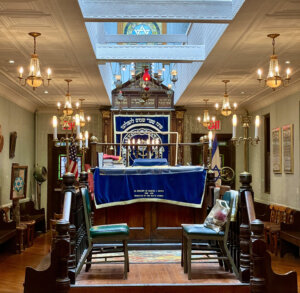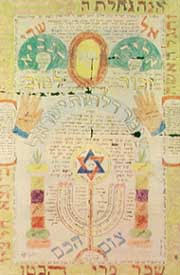How this Romaniote synagogue keeps a Jewish ‘minority within a minority’ alive
Kehila Kedosha Janina, a small synagogue on the Lower East Side, represents a tiny Jewish community that lived in Greece for over 2,300 years

Graphic by Angelie Zaslavsky
In what was once the women’s gallery of the synagogue Kehila Kedosha Janina, an exquisitely embroidered antique wedding gown hangs behind protective glass.
The gown is one of many artifacts and photographs on display in Memory, an exhibit on view at the New York City synagogue which allows visitors to glimpse what life was like for Romaniote Jews, a tiny Jewish minority distinct from the Ashkenazi and Sephardic traditions.
Just as importantly, the exhibit demonstrates how KKJ, the only Romaniote synagogue in the Western Hemisphere, preserves the community’s traditions and bolsters its living culture.
“For many years after the synagogue was founded, it was vibrant and active. Over time the numbers went down, but then we opened the museum. It gave new life and energy,” said Marc Winthrop, who joined the 96-year-old synagogue 25 years ago.
Settling in Greece as early as the 1st century C.E., they lived there for over 2,300 years, evading the expulsions that befell most other Jewish communities in the European diaspora. Instead of speaking Ladino like the Sephardic Jews who settled in Greece after the Spanish Inquisition, Romaniotes spoke Judeo-Greek. They lived in relative isolation in places like Ioannina, a small Greek city tucked between the Pindus mountains and the Albanian border, until in the late 1800s, poverty and political upheaval compelled the first Romaniote Jews to immigrate to the United States.
“They are a minority within a minority within a minority,” said Marcia Haddad Ikonomopoulos, the museum director at Kehila Kedosha Janina.

Growing up in Duluth, Minnesota, Marc Winthrop first learned about his Romaniote heritage more than a decade ago. He had traveled to Greece to learn about the birthplace of his mother, a Holocaust survivor. While there, he traced his family’s lineage and learned she was actually Romaniote, not Sephardic as she originally believed. The discovery sparked an interest to learn more.
Today, Winthrop, who has lived in New York for more than 20 years, attends Shabbat services, leads Sunday museum tours, and serves on the board of the Lower East Side synagogue.
While Romaniote immigrants established KKJ as a congregation in 1907, the synagogue on Broome and Allen Street didn’t open until 1927.
These days, the narrow synagogue stands sandwiched between red brick apartment buildings. The delicatessens, tailor shops and candy stores that once neighbored it have given way to bubble tea shops, jewelry stores, and trendy restaurants.
Hebrew symbols adorn the façade, which is punctuated by stained glass windows adorned with Stars of David. Above the main entrance two stone lions representing the tribe of Judah stand guard over a bas-relief sculpture of the Ten Commandments.
Inside, the ice-blue walls glimmer with stenciled silver flowers. Memorial plaques testify to the many generations who worshiped here. The ark holds several Torahs, including one dating back to 1750.
The synagogue’s gleaming interior is the result of significant ongoing renovations that began in 2005, the same year the synagogue became an official New York City landmark.
“That put us on the map,” Ikonomopoulos said. She was speaking literally — the nearby Spring Street subway stop now features a sign for the synagogue.
Ikonomopoulos, who grew up believing she was Sephardic, discovered she has Romaniote ancestry when she took a DNA test several years ago. She wants people to understand that the synagogue is planning for its future, even as the current exhibit highlights the congregation’s past.
Walking through Memory, Ikonomopoulos explained how she rotates the displays so different families have a chance to display cherished items. Vintage photographs show families garbed in their finest homemade suits and dresses, some with fur accents. The exhibit also features several personal items, from baking tins and teacups to prayer books and even a pair of slightly rusted shears that belonged to the late Hy Genee, KKJ’s president and spiritual leader for over 50 years.
On the walls hang five framed Alefs. Unique to the Romaniote community, these embellished documents served as a birth certificate and protective amulet for baby boys during the 40 days after their circumcision. Today KKJ has the largest collection of Alefs worldwide.

Stopping in front of swatches of red and white fabric and a Singer sewing machine, Ikonomopoulos explained how many of the newly arrived immigrants worked in the lowest tier of the garment industry, making women’s underwear and housecoats.
“If you had a sewing machine, you were an entrepreneur,” she said.
During WWII, some KKJ congregants served in the U.S. Army, two of whom were killed. Some attended school. Some became educators and others physicians. Meanwhile, they wrote to any extended family who remained in Ioannina.
It wasn’t until after the war that they learned that the Nazis had murdered 87 percent of Greek Jews, the largest percentage of any officially occupied country. Of Ioannina’s Jews, only about 50 survived. Among them was Esther P. Mordechai.
On March 25, 1944, Mordechai’s family was rounded up with the rest of Ioannina’s Jewish community. Loaded onto open trucks, they were driven to a warehouse in the city of Larissa and then sent to Athens. From there the Germans crammed them into cattle cars destined for Auschwitz-Birkenau.
Most of the estimated 2,500 Romaniote Jews who arrived at the death camp were gassed on arrival. Mordechai was the only one of her immediate family to survive. She returned to Ioannina after the war and married another survivor, eventually moving to the United States. Visitors to Memory can see a small black-and-white photograph of Mordechai taken in Ioannina cradling her baby alongside three other survivor mothers.
As the synagogue’s continued existence proves, the Holocaust did not end Romaniote Jewish life. But the community’s narrow escape from extinction left congregants like Winthrop and Ikonomopoulos with a keen sense of responsibility toward the synagogue’s role in safeguarding Balkan Jewish life.
That’s why Ikonomopoulos oversees the synagogue’s many revolving exhibitions. It’s why, each May, hundreds of people pour into the streets for the annual Greek Jewish festival where freshly baked bourekas and baklava perfume the air.
That’s why the synagogue hosts bar and bat mitzvahs each year, as well as an active brotherhood and sisterhood. That’s why a minyan gathers on Shabbat holidays to pray in traditional Hebrew and Judeo-Greek.
“It’s why we have a great kiddush,” Ikonomopoulos quipped.














